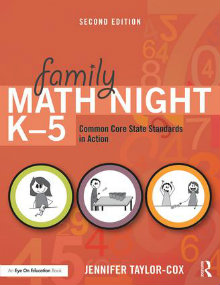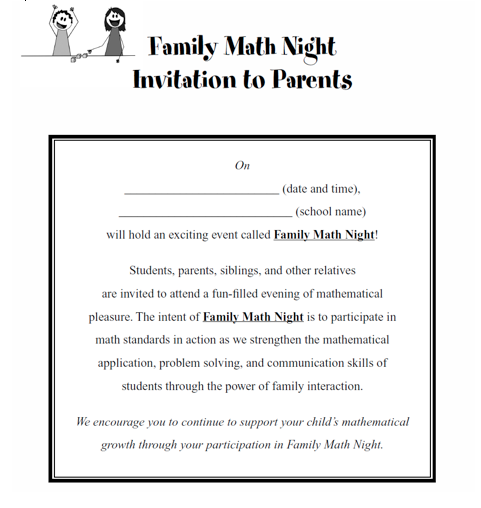Family Math Night from Start to Finish
Family Math Night K-5: Common Core State Standards in Action, 2nd edition
By Jennifer Taylor-Cox
(Routledge/Eye on Education, 2017 – Learn more)

Are you searching for resources for a “Family Math Night”? Getting families involved in their child’s education is important, and hosting a “Family Math Night” is a great way to gain this participation.
The perfect “go to“ resource to use if you are considering hosting a “Family Math Night” is Jennifer Taylor-Cox’s book, Family Math Night K-5: Common Core State Standards in Action. This hands-on book will make your night a success, fun, full of learning, and packed with real world connections!

The author, an educational consultant for many school districts throughout the United States, keeps in mind how busy teachers are in their daily practice. This updated edition of her book is written in a straightforward, easy-to-read and easy-to-adapt format.
If you tend to skip reading an introduction to get to the “meat” of a book, please don’t skip this one. These six pages will guide the teacher as they begin to plan a most spectacular “Math Night.”

Copyrighted material.
Before the activities are presented, Taylor-Cox explains the “Whys, Whats, and Hows” of the book to guide the teacher as he/she begins to organize this fun filled night. Honestly, after reading the first chapter, you will find that most of your questions have been answered, and you will be ready to GO!
- Why Math Night?
- How is the book organized?
- How do the activities connect to the Common Core State Standards?
- Why use manipulatives in mathematics?
- Why are questions included?
- Why are there challenges for each activity?
- Why additional tips are included?
- What do I do as the teacher during “Math Night”?
Standards, materials, and hints
The first page of each activity lists the materials needed, math standards applied, and hints. Some of the hints include ideas for substitution materials, such as how to make paper Cuisenaire rods if you don’t have them in your teacher’s toolkit.
Each “Math Station” highlights two mathematical practices that were specifically chosen for the activity. However, you might find that there are other mathematical practices that could be included in the math station. All you need to do is decide what standards you want to cover, choose the activities, and follow the step-by-step directions.
Although each of the stations uses manipulatives, most of the manipulatives are found in every classroom, can be copied, or are easily and cheaply obtained, such as decks of cards, magnets, paper clips, etc. Everything you need is in the book, and the author has graciously provided a link for a free online download of the printable resources.
By grade level and content
The subsequent chapters are organized by math content and grade level so you can find the activity to meet your students’ needs. Chapter two presents activities for primary students (prekindergarten to second grade) and chapter three for intermediate students (third to fifth grade).
The second edition of Family Math Night, Grades 6-8
will be available in May 2018.
If you haven’t hosted a family math night at your school, think about it and purchase this book as your special partner. If you have hosted a family math night, you need this book to get your students and families excited about math.
And you will be equally excited. Your favorite part of the evening will be watching your students and their families enjoying time together, having fun, being engaged in learning, and wanting to come back to the next math night!
Linda Biondi recently retired as a fourth grade teacher at Sharon Elementary School in Robbinsville, NJ where she was a long-time Morning Meeting practitioner. She is the recipient of several educational grants, a Teacher Consultant with the National Writing Project, and was a participant on the NJ Department of Education Teacher Advisory Panel and with ECET2 Celebrate Teaching.

































